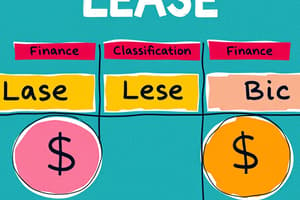Podcast
Questions and Answers
Briefly explain the situation that necessitates the re-assessment of lease liability under IFRS for a lessee.
Briefly explain the situation that necessitates the re-assessment of lease liability under IFRS for a lessee.
The re-assessment of lease liability is required when a lessee initially makes some estimates regarding the lease, and subsequently, there is a change in those estimates.
List three factors that may cause a re-assessment of the lease liability for the lessee.
List three factors that may cause a re-assessment of the lease liability for the lessee.
Changes in the estimate of lease term, changes in the K.L.I.B.O.R., and changes in the estimate regarding BPO recording.
In the context of lease re-assessment, what interest rate should be used to recompute the lease liability, and when should it be applied?
In the context of lease re-assessment, what interest rate should be used to recompute the lease liability, and when should it be applied?
The revised estimates should use the rate of interest that prevails on the re-assessment date and should be applied to re-assess the lease liability.
Outline the subsequent accounting treatment after re-assessment related to the ROUA.
Outline the subsequent accounting treatment after re-assessment related to the ROUA.
What is the difference between subsequent accounting from case A to case B, referring to lease liability measurement?
What is the difference between subsequent accounting from case A to case B, referring to lease liability measurement?
How should a lessee account for variable lease payments not based on an index or rate?
How should a lessee account for variable lease payments not based on an index or rate?
In a sublease arrangement, briefly describe the accounting rules that apply to the head lessor and the sublessor.
In a sublease arrangement, briefly describe the accounting rules that apply to the head lessor and the sublessor.
On the sublease date, how is the sublease classified, and what factors determine this classification?
On the sublease date, how is the sublease classified, and what factors determine this classification?
In a finance sublease, explain the initial accounting treatment by the sublessor for the ROUA and the lease receivable.
In a finance sublease, explain the initial accounting treatment by the sublessor for the ROUA and the lease receivable.
How should the sublessor subsequently measure the lease liability after entering into a sublease agreement?
How should the sublessor subsequently measure the lease liability after entering into a sublease agreement?
If a sublease is classified as an operating lease, what accounting treatment should be applied to the ROUA and lease liability in the sublessor's books?
If a sublease is classified as an operating lease, what accounting treatment should be applied to the ROUA and lease liability in the sublessor's books?
What accounting treatment is applied when the original lessee opts for the low-value asset or short-term lease exception in a sublease scenario?
What accounting treatment is applied when the original lessee opts for the low-value asset or short-term lease exception in a sublease scenario?
Define lease modification under IFRS from the perspective of a lessee.
Define lease modification under IFRS from the perspective of a lessee.
Give any two examples of events that might lead to lease modification.
Give any two examples of events that might lead to lease modification.
Outline the subsequent accounting treatment if the lease modification is accounted for as a separate contract.
Outline the subsequent accounting treatment if the lease modification is accounted for as a separate contract.
Explain how a lessee may account for a discount given by the lessor on additional rental equal to the amount of a marketing or commission cost.
Explain how a lessee may account for a discount given by the lessor on additional rental equal to the amount of a marketing or commission cost.
In a sale and leaseback transaction, what is the key determinant for classifying the transaction as a sale?
In a sale and leaseback transaction, what is the key determinant for classifying the transaction as a sale?
If a sale and leaseback transaction qualifies as a sale, how should the seller-lessee account for any difference between the transfer price and the fair value of the asset?
If a sale and leaseback transaction qualifies as a sale, how should the seller-lessee account for any difference between the transfer price and the fair value of the asset?
Outline 2 of the key differences in accounting treatment between a seller-lessee and a buyer-lessor if a transfer of assets is classified as not a sale.
Outline 2 of the key differences in accounting treatment between a seller-lessee and a buyer-lessor if a transfer of assets is classified as not a sale.
If on the same date, estimates are revised related to the Lease Liability, and these estimates belong to both Case A & Case B, what rules shall technically apply?
If on the same date, estimates are revised related to the Lease Liability, and these estimates belong to both Case A & Case B, what rules shall technically apply?
Flashcards
Re-assessment of Lease Liability (Lessee)
Re-assessment of Lease Liability (Lessee)
A change in the estimate initially made by the lessee regarding the lease, such as the lease term, residual value, or amount expected to be payable.
Re-assessment: Case A Steps
Re-assessment: Case A Steps
Determine balances, then re-compute using revised estimates and the revised interest rate on the re-assessment date, then compare the existing and recomputed Lease Liability
Re-assessment subsequent steps
Re-assessment subsequent steps
Re-assess the lease liability by depreciating the ROU asset using the revised estimate and measure the lease liability in the lease schedule.
Re-assessment: Case B
Re-assessment: Case B
Signup and view all the flashcards
Variable Payments
Variable Payments
Signup and view all the flashcards
Variable Payment (Lessor)
Variable Payment (Lessor)
Signup and view all the flashcards
Variable Payment (Lessee)
Variable Payment (Lessee)
Signup and view all the flashcards
Sub-Lease
Sub-Lease
Signup and view all the flashcards
Classifying SubLeases
Classifying SubLeases
Signup and view all the flashcards
Sublease Date
Sublease Date
Signup and view all the flashcards
Subsequent to Sublease
Subsequent to Sublease
Signup and view all the flashcards
Sub-lease Date. Case #02:
Sub-lease Date. Case #02:
Signup and view all the flashcards
Sub-lease Date: Case #03
Sub-lease Date: Case #03
Signup and view all the flashcards
Lease Modification (Lessee)
Lease Modification (Lessee)
Signup and view all the flashcards
Increase in Underlying Assent
Increase in Underlying Assent
Signup and view all the flashcards
Lease Modification Shall
Lease Modification Shall
Signup and view all the flashcards
Transfer of Asset (Sale)
Transfer of Asset (Sale)
Signup and view all the flashcards
Sale-leaseback
Sale-leaseback
Signup and view all the flashcards
Asset transfer (Not Sale)
Asset transfer (Not Sale)
Signup and view all the flashcards
Points To Consider
Points To Consider
Signup and view all the flashcards
Study Notes
- These notes cover the re-assessment of lease liability, lease modifications, and sale and leaseback transactions under IFRS, focusing on the lessee's perspective.
Re-assessment of Lease Liability (Lessee)
- Re-assessment occurs when there's a change in the initial estimates made in a lease agreement.
- Examples of situations requiring re-assessment include changes in the lease term, K.L.I.B.O.R (Key London Interbank Offered Rate), estimates for recording BPO (Business Process Outsourcing), amounts expected to be payable, and variable payments based on an index like CPI (Consumer Price Index).
Case A: Re-assessment Scenarios
- Changes in lease term estimates.
- Changes in K.L.I.B.O.R.
- Changes in estimates for recording BPO.
- Step 1: Determine the balance of the lease liability (LL) and Right-of-Use Asset (ROUA) on the re-assessment date.
- Step 2: Re-compute the lease liability using revised estimates and the prevailing interest rate on the re-assessment date (revised interest rate).
- Step 2.1: Compare the existing lease liability to the re-computed lease liability.
- If the existing LL is greater than the re-computed LL:
- Leases Decrease.
- Decrease the amount.
- If the re-computed LL is greater than the existing LL:
- Leases increase
- The increase in amount affects both the LL and ROUA.
- If the existing LL is greater than the re-computed LL:
- Update the balances of ROUA and LL after the journal entry.
- Step 3: Subsequent to the re-assessment, ROUA is depreciated using the revised estimate, and the LL is measured in the lease schedule using the revised interest rate.
Case B: Re-assessment Scenarios
- Changes in estimates regarding amounts expected to be payable
- Changes in variable payments based on an index (CPI).
- Step 1: Same as Case A.
- Step 2: Same as Case A, except use the original (unchanged) interest rate for PV (Present Value) calculation.
- Step 2.1: Same as Case A.
- Step 3: Same as Case A, except lease liability is measured in the lease schedule using the original (unchanged) interest rate.
- Notes indicate that if elements affecting the estimate change already, the interest factor is already incorporated, so avoid re-calculating the PV.
Variable Payments Not Based on an Index
- These are payments like installments based on sale amounts.
- For lessors:
- These payments shouldn't be included in the lease payment.
- Should record it as other income in the year to which it belongs.
- For lessees:
- Should record it as an expense in the year to which it belongs.
Sub-Lease Scenarios
- A sub-lease involves a head lessor (MAH), an intermediate lessor (HBS), and a lessee (MUGHERS).
- Accounting rules applied by lessor rules apply to the original lessor and, in some respects, to the intermediate lessor. Lessee rules apply to the sub-lessee
Sub-Lease Accounting
- Determination if transfers qualify as Sale
- On the date of the sub-lease, record ROUA and LL in books.
- If the sub-lease is classified as a finance lease or an operating lease (as an intermediate lessor), relevant indicators should be considered.
- Finance Lease (Case #01):
- Sub-lease is a finance lease.
- Step 1: Determine the balance of LL and ROUA on the sub-lease date.
- On the sub-lease date, ROUA is de-recognized, and a Lease Receivable (LR) is recorded equal to the PV of the GIL using the implicit interest rate of the lessor.
- Gain or Loss indicated a part of P&L, or added/subtracted from balance of the ROUA/Asset.
- Subsequent Steps
- Lease receivable from sub-lessee shall be measured as per schedule
Operating Lease (Case #02)
- Step 1: Determine the balance of LL and ROUA on the sub-lease date.
- ROUA/PPE shall be retained in the books of the intermediate lessor and shall follow operating lease accounting as a lessor.
- Rent income on SLAM (Sub-Lease Accounting Method)
- Subsequent accounting:
- ROUA shall be depreciated
- LL shall be measured according to schedule; and,
- Rent income shall be recorded on EL17.
- Subsequent accounting:
Situation: Low Value Asset (Case #03)
- From 1st day of lease
- The original lessee opts for an exception, treating the lease of a low-value asset or short-term lease.
- No ROUA or LL is recorded on books
- Sublease shall always be classified as an operating lease
- Follow operating lease accounting as lessor and original lessee continue to record rent expense
Lease Modification (Lessee)
- A change in the scope or consideration of a lease that was not part of the original terms and conditions.
- Examples:
- Increase or decrease in consideration (installment amount)
- Increase/decrease lease term
- Increase/decrease underlying asset
- Accounting depends on whether the modification is a separate contract
Case A: Lease Modification
- Increase in underlying asset and additional consideration per market terms on modification date.
- If ROUA, LL rate at new rate then the lease modification shall be accounted for as a separate contract.
Case B: Lease Modification
- If not Case A (increase in underlying asset), then consider Case B.
- (1) Decrease in scope or (2) others in scope if not (1)
- Cases where the lessor gives a discount on additional rental equal to the marketing/commission cost, and if allowed by the lessor, then additional discount be marked as market terms
Accounting Treatment of Case B:
- Case B(li) Determine balance of ROUA / LL on modification date
- (1) identify decrease in scope adjustment
- update balance of ROUA and LL
- (1) identify decrease in scope adjustment
- Case B(lii) Determine balance of ROUA and LL on the effective date
- (1) Calculate change in LL using interest rate on lease modification
- LL increase (1a) OR LL decrease (1b)
- (1) Calculate change in LL using interest rate on lease modification
Transfer of Asset: Sale vs. Not Sale
- Addresses whether a transfer of assets satisfies the requirements of IFRS 15 to be considered a sale.
Sale Criteria:
- If Risk/Reward (controls) of Asset transferred to buyer lessor, is transfer of sale.
- Seller lessor would record Bank and ROUA (recalculate value based on P/L, balance)
Not Sale Criteria:
- If Risk/Reward (controls) of Asset NOT transferred to buyer lessor
- Seller lessor treats the event as a loan.
Seller Lessee Case
- Sale price equals FV.
- In cases where the sale occurs, a ROUA recorded at a proportion of CV/FV.
- Record Bank and ROUA (recognize P/L from balance).
- Seller shall follow lessee rules
- Sale price is > FV -> (Additional Financing)
- Asset proportional
- Determine where it is asset proportional/Additional Financing, and recognize as such.
- Subsequently, lessee rules shall apply
- Sale Value < FV -> (Prepayment)
Buyer Lessor
- Sale and lease back accounting and subsequent actions based on whether it is loan or FV transaction.
- Asset sales between related parties shall be accounted for the same way- look for indicators of a sale based on IFRS 15;
- Accounting:
- operating lease (Rent Income)
- Financial asset accounting (ACM)
Transfer of Asset is NOT a Sale:
- Seller Lessee holds Financial Liability (Loan Obtainer)
- Buyer Lessor holds the Financial Asset (Loan Provided) -Risk & Rewards are retained with lessee NOT transferred to Buyer.
- Does not de recognize asset; Does not recognized asset
- Subsequent A/c: ACM FL Subsequent : ALEM FA
- Subsequent Ale:
- Asset@end of leas term: Retained with lessee -> Same.
- Lease Modifies in a point of where Then technically rules of applies
Lessor Substitution Right
- Is there substantive substitution rights?
- YES: Not a lease agreement
- NO: Is a lease agreement determined through looking at factors
Studying That Suits You
Use AI to generate personalized quizzes and flashcards to suit your learning preferences.




